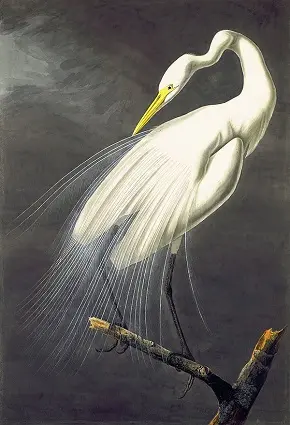A white heron
Psychoanalytical Criticism of "A White Heron" by Jaseline, Connie, Jack.

The audience sit at the edge of their seat, restless to hear this amazing presentation. Jaseline, Connie, and Jack make their way up to the front of the classroom prepared to entertain the class to the fullest. They begin with introducing their lens, the psychoanalytical lens placed on the short story, "A White Heron". The hosts begin with the definitions of dream analysis, symbolism, family dynamics, conflict, and resolution. They also briefly describe the conscious, preconscious, and unconscious of a human. This is better known as a person's ego, super ego, and id. The presenters then give a summary of the story. This story begins with a backround of the nine year old protagonist, Sylvia, who lives with her grandmother on a farm. Sylvia meets a young hunter who is searching for the white heron. Sylvia climbs a tree to find the heron's nest, she then spots the white heron's nest soon later. After witnessing the beauty and miracles of nature while perched on the tree, she realizes that she cannot risk the heron's life, not uttering a word to the hunter. The presenters then interject the summary with a thought provoking question to the class, they ask what would have brought her more grief, telling the hunter the truth or risking the heron's life. It is important to understand the family dynamics in this story. Sylvia grew up with a lack of positive male influence, she lived with her grandmother on a lonely farm, she is far more vulnerable to male figures and in this story, the hunter presents himself as a guiding male figure. There are many unconscious motives present in this story, "id" is the unconscious intuitive aspect of consciousness, it satisfies physical needs, wants, emotional impulses, and desires. The companionship with nature vs the hunter's relationship with nature is hard to distinguish. Due to the subdued presence of id and the presence of superego, ego is not unleashed. Next, the presentation covers conflict and resolution and symbolism. Id coming out is ego learning to compromise between id and super ego. Symbolism refers to specific objects that represent psychological meanings. A jack knife is one example, it symbolizes heron's life being in Sylvia's hands. Climbing the tree broadens Sylvia's perspective, and taxidermy is the hunter's possession of nature. Advancing to the last segment of the presentation, the presenters provide us with information about the author. Sarah O.Jewett loved travelling with her father to fishing and farming towns, and she wrote stories on declining seaport towns. This concludes this presentation. Finally, the class is split into groups to read a passage and psychoanalyze the author and the characters. Overall, I found the presentation to be extremly detailed and specific. The communication was perfect with no mishaps or any stumbles, showing the effort that went into the performance.